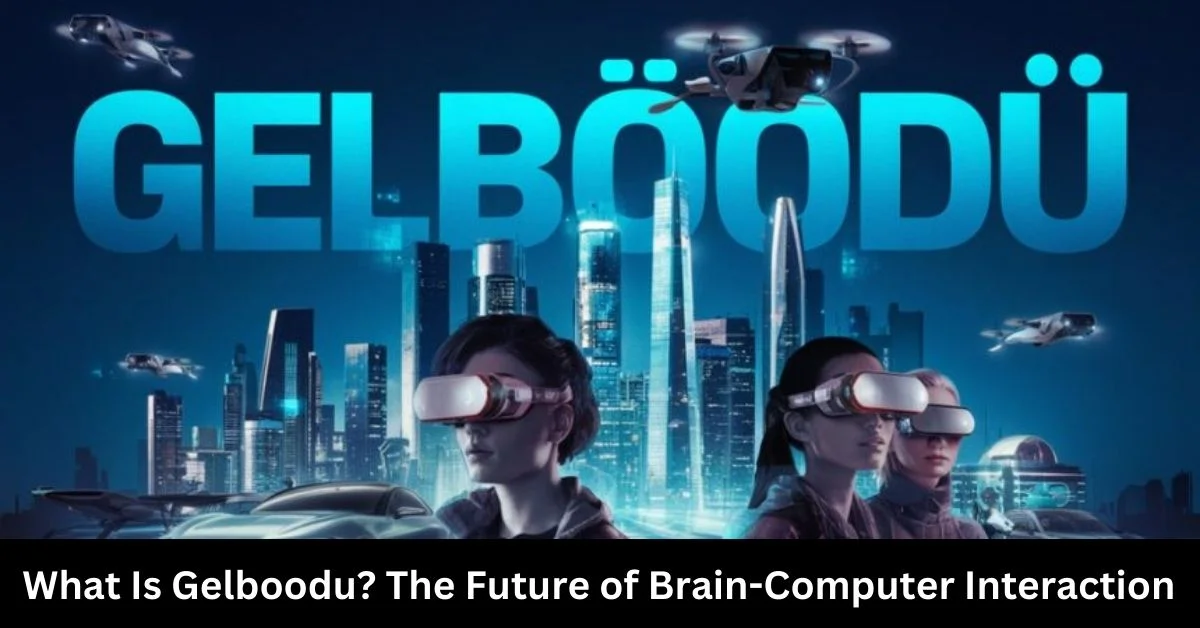In the rapidly evolving world of technology, the name gelboodu has recently emerged as a symbol of innovation and cutting-edge advancements. This breakthrough device, invented to enhance human-machine interaction, has captured the attention of tech enthusiasts and futurists alike. From revolutionising communication to transforming industries, gelboodu is paving the way for a future where technology and humanity coexist more harmoniously than ever before.
This article delves deep into the origins, applications, and future potential of gelboodu, exploring its transformative role in various sectors.
What is Gelboodu?
Gelboodu is a sophisticated technology designed to bridge the gap between artificial intelligence (AI) and human cognition. Unlike traditional devices that rely on user input through physical means such as keyboards or touchscreens, gelboodu leverages advanced neural interfaces to create a seamless, thought-driven interaction.
At its core, gelboodu operates by interpreting neural signals from the human brain, allowing users to control digital devices, communicate, and even create complex commands without the need for manual input. This revolutionary concept marks a significant step forward in the ongoing development of brain-computer interfaces (BCI), which have long been viewed as the future of human-computer interaction.
The Science Behind Gelboodu
To understand gelboodu, it’s essential to grasp the technology’s underlying scientific principles. The device relies on neural mapping and electrical signal interpretation, combining neuroscience with AI. Here’s how it works:
- Neural Mapping: The device scans the brain’s neural activity, identifying patterns that correspond to specific thoughts or actions. These patterns are then translated into digital commands.
- AI Interpretation: An integrated AI system interprets the neural signals, making predictions and executing commands in real-time. This interaction allows for instantaneous responses, eliminating delays commonly associated with traditional input methods.
- Feedback Mechanism: Gelboodu features a feedback system, where the device provides real-time information to the user based on their mental commands. This feedback loop enhances accuracy and efficiency over time, as the AI system learns the user’s unique neural patterns.
This seamless integration of human thought and machine execution sets gelboodu apart from other technologies in the brain-computer interface field.
Applications of Gelboodu
The versatility of gelboodu opens the door to a wide range of applications across various industries. Here are some of the most notable sectors that are poised to benefit from this groundbreaking technology.
Healthcare
The healthcare industry stands to gain immensely from gelboodu, particularly in the field of neuroprosthetics and assistive technologies. Patients with mobility impairments, such as those suffering from paralysis, can use gelboodu to control robotic limbs and prosthetic devices through their thoughts. This technology offers new hope to individuals with spinal cord injuries, degenerative diseases, and amputations, giving them the ability to regain independence and perform daily tasks more easily.
In addition to prosthetics, gelboodu is also revolutionising telemedicine. Surgeons can control robotic instruments during remote surgeries with unprecedented precision, expanding access to complex medical procedures for patients in remote or underserved regions.
Communication
Communication is at the heart of human interaction, and gelboodu is redefining how people communicate in the digital age. By enabling direct brain-to-device communication, this technology has the potential to eliminate traditional barriers such as language and physical limitations.
Imagine being able to send messages, emails, or social media posts simply by thinking about them. Gelboodu allows users to compose, edit, and send digital communications with the power of thought, streamlining the process and reducing the time spent typing or speaking.
Furthermore, gelboodu can be used to facilitate communication for individuals with conditions like ALS (Amyotrophic Lateral Sclerosis), locked-in syndrome, or other neurological disorders that impair speech. By using their thoughts, these individuals can communicate more effectively, improving their quality of life and interactions with others.
Entertainment and Gaming
The entertainment industry is another sector where gelboodu promises to make a profound impact. The gaming world, in particular, is eager to embrace this technology, which allows players to control game elements using their thoughts, thus creating a more immersive experience.
For instance, virtual reality (VR) gaming could become more intuitive and responsive as gelboodu enables direct brain-to-game interaction. Players would no longer need to rely on controllers or physical movements; instead, they could interact with virtual environments as naturally as they do in the real world. This breakthrough could redefine the landscape of gaming and virtual experiences, offering entirely new levels of engagement and creativity.
Military and Defense
In the realm of defence and military operations, gelboodu has immense potential to revolutionise how soldiers engage with technology. For example, gelboodu could be used to control drones, robotic systems, and other unmanned vehicles on the battlefield, allowing military personnel to execute complex missions with greater precision and safety. The ability to command systems through thought alone could reduce response times and improve coordination in high-stakes environments.
Moreover, gelboodu may be used to augment decision-making capabilities during critical moments, enabling military commanders to process vast amounts of data in real-time and make informed decisions rapidly. The integration of AI into this process can assist in analysing battlefield conditions, threat levels, and resource management.
Education and Learning
The educational sector is also primed for transformation thanks to gelboodu. By leveraging thought-driven interfaces, learning can be more personalised, interactive, and adaptive. For example, students could use gelboodu to control virtual simulations or interact with digital educational platforms without needing to physically engage with computers or tablets.
Moreover, students with physical disabilities or learning challenges could benefit from the accessibility of gelboodu, which offers new ways to engage with course material and collaborate with peers.
Also Read: The Role of The Honangen Sword civil war in Japanese History
The Ethical Considerations of Gelboodu
As with any advanced technology, gelboodu raises significant ethical concerns that need to be addressed. While the potential benefits are vast, it is crucial to consider the implications of such a powerful tool.
Privacy Concerns
One of the most pressing concerns surrounding gelboodu is data privacy. Since the technology relies on accessing and interpreting neural signals, it raises questions about who owns this data and how it is used. There is potential for misuse if companies or governments gain access to individuals’ neural data, leading to ethical dilemmas around surveillance, consent, and autonomy.
To mitigate these risks, robust privacy frameworks must be established to protect users’ data. Additionally, transparency regarding data collection and usage practices is essential to building trust between consumers and technology providers.
Mind Control and Manipulation
Another critical concern is the potential for mind manipulation. With the ability to directly influence brain activity, gelboodu could be misused to alter thoughts, beliefs, or behaviours without the user’s knowledge or consent. Such scenarios raise profound ethical questions about free will and human agency.
Researchers and developers must ensure that strict safeguards are in place to prevent malicious use of gelboodu. Ethical guidelines should prioritise user autonomy and informed consent, ensuring that individuals retain control over their own thoughts and decisions.
Access and Inequality
As with many cutting-edge technologies, gelboodu also risks contributing to societal inequalities. If access to this technology is limited to wealthy individuals or nations, it could exacerbate existing disparities. Ensuring that gelboodu is accessible and affordable for all people, regardless of socio-economic background, is crucial for promoting equity in its use.
Governments, tech companies, and international organisations will need to collaborate to create policies that prioritise universal access to gelboodu and its benefits.
The Future of Gelboodu
The future of gelboodu is full of promise, but it also comes with challenges that must be addressed. As this technology continues to evolve, several key trends and developments will likely shape its trajectory.
Further Integration with AI
As AI continues to advance, we can expect gelboodu to become more sophisticated in its ability to interpret and predict human thoughts. This evolution will likely result in even more intuitive interactions between users and their devices, making gelboodu a natural extension of the human mind.
Further research into machine learning and neural networks will also enhance the device’s ability to learn from users over time, improving accuracy and personalization.
Expansion into New Industries
While gelboodu is already making waves in sectors such as healthcare, communication, and entertainment, its potential applications are far-reaching. In the coming years, we can expect to see the technology expand into industries such as manufacturing, transportation, and space exploration.
For example, gelboodu could be used to control complex machinery in factories, allowing workers to oversee production lines without physical intervention. Similarly, in the field of space exploration, astronauts may use gelboodu to operate robotic systems and spacecraft, enhancing their ability to navigate harsh environments.
Democratisation of Gelboodu Technology
One of the most exciting prospects for the future is the democratisation of gelboodu. As production scales up and costs decrease, this technology could become accessible to a broader audience, transforming how society interacts with machines and digital systems.
The development of affordable, user-friendly versions of gelboodu will empower more individuals to integrate this technology into their daily lives, from personal communication to professional tasks.
Conclusion
The rise of gelboodu represents a watershed moment in the world of technology. By enabling thought-driven interactions with digital systems, this revolutionary device is reshaping industries, improving the quality of life for individuals with disabilities, and opening up new possibilities for human-machine collaboration.
However, with great power comes great responsibility. As gelboodu continues to evolve, society must address the ethical, privacy, and access issues it presents. By fostering open discussions and responsible innovation, we can harness the full potential of gelboodu while safeguarding the rights and dignity of all individuals.






